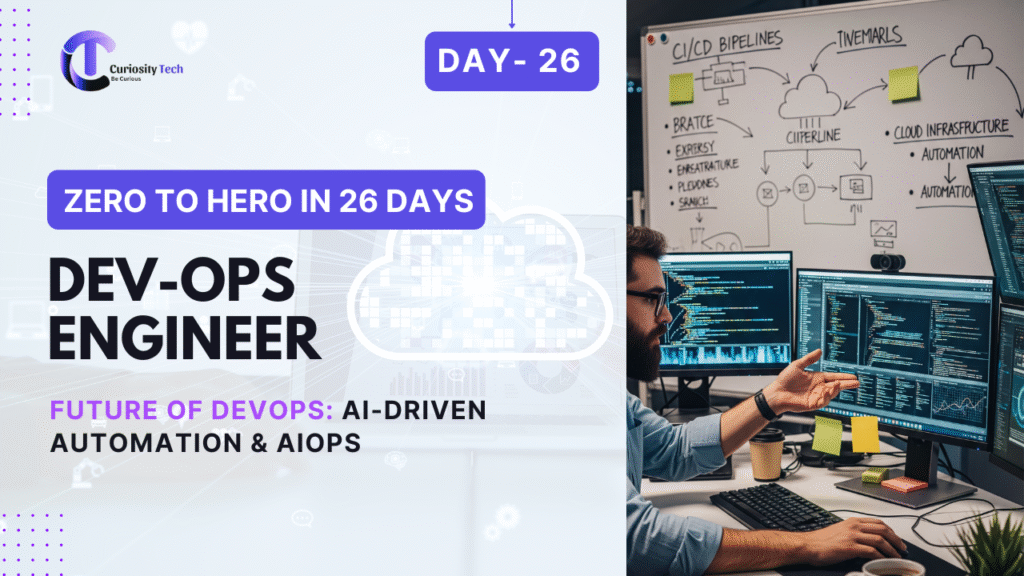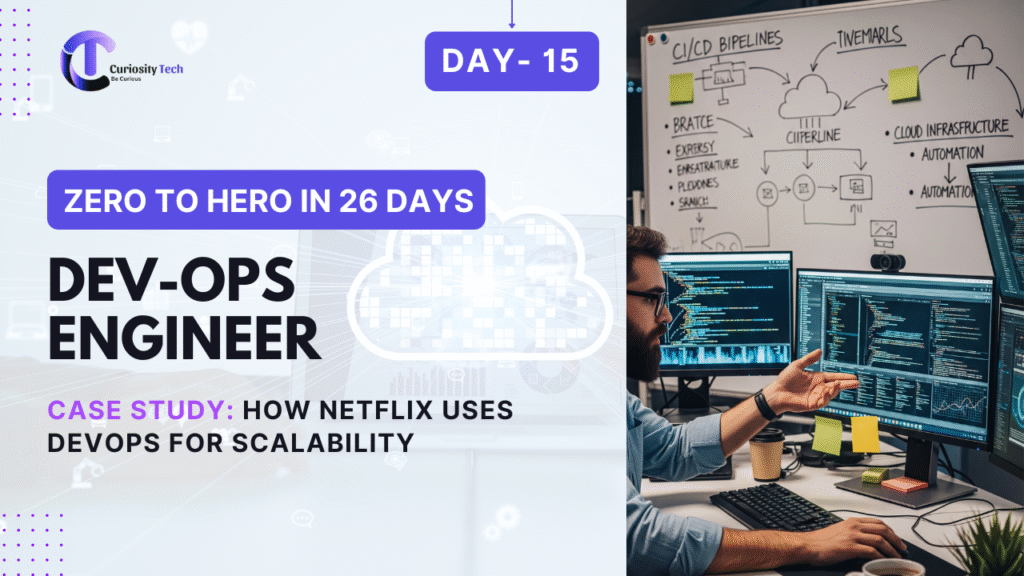Day 26 – Future of DevOps: AI-Driven Automation & AIOps
The DevOps landscape is entering a new era where Artificial Intelligence (AI) and Machine Learning (ML) are becoming central to automation, reliability, and operational excellence.
In 2025 and beyond, AIOps and AI-driven DevOps are transforming how software is developed, deployed, monitored, and optimized.
At CuriosityTech.in, learners explore AI-powered DevOps workflows, gaining hands-on experience with predictive analytics, anomaly detection, and automated remediation that shape the future of enterprise software delivery.
1. What is AI-Driven DevOps and AIOps?
AI-Driven DevOps: Integrates AI/ML algorithms into DevOps pipelines to optimize builds, deployments, testing, and monitoring automatically.
AIOps (Artificial Intelligence for IT Operations): Uses data analytics, machine learning, and automation to monitor systems, predict failures, and enable self-healing operations.
Key Benefits:
- Reduced Mean Time to Recovery (MTTR)
- Automated anomaly detection
- Predictive scaling and resource optimization
- Enhanced decision-making with data-driven insights
2. Key Components of AI-Driven DevOps
| Component | AI/ML Role | Tools/Technologies |
|---|---|---|
| Monitoring & Observability | Predictive anomaly detection, performance forecasting | Prometheus + ML, Dynatrace AI, New Relic Applied Intelligence |
| CI/CD Optimization | Predictive build/test prioritization | Jenkins + AI plugins, GitHub Actions with ML analysis |
| Incident Management | Automatic root cause analysis and remediation | Moogsoft, BigPanda, Splunk AI |
| Resource Management | Predictive auto-scaling, cost optimization | CloudWatch + AI, Kubernetes HPA with ML |
| Security & Compliance | Automated vulnerability detection, risk scoring | Snyk + AI, Aqua Security, Prisma Cloud AI |
3. AI-Driven DevOps Workflow Diagram
Developer Code Commit
│
▼
CI/CD Pipeline
┌─────────┬─────────────┐
│ Build & Test Automation│
│ ML Predicts Failed Jobs│
└─────────┼─────────────┘
│
▼
Deployment Stage
┌─────────┬─────────────┐
│ Auto-Scaling & Rollback│
│ ML Predicts Failures │
└─────────┼─────────────┘
│
▼
AI-Powered Monitoring
┌─────────┬─────────────┐
│ Anomaly Detection │
│ Predictive Maintenance │
│ Root Cause Analysis │
└─────────┼─────────────┘
│
▼
Feedback & Optimization
(Continuous Learning)
Description:
AI-driven DevOps pipelines use continuous learning from historical data, enabling predictive decisions in build optimization, deployment, scaling, and incident management.
4. Emerging Tools & Platforms for AI-Driven DevOps
| Category | Tools | AI Capabilities |
|---|---|---|
| Monitoring & Observability | Dynatrace, Moogsoft, New Relic | ML-based anomaly detection, predictive insights |
| CI/CD Automation | Jenkins AI plugins, GitHub Actions with ML | Predict failing builds, optimize test execution |
| Security & Compliance | Snyk AI, Prisma Cloud AI | Risk scoring, vulnerability prioritization |
| Incident Management | BigPanda, PagerDuty with AI | Root cause analysis, alert correlation |
| Resource Optimization | CloudWatch AI, Kubernetes HPA with ML | Predictive scaling and cost optimization |
At CuriosityTech.in, learners experiment with AI-powered monitoring dashboards, predictive build pipelines, and auto-remediation scenarios, preparing them for next-gen DevOps roles.
5. Advantages of AI in DevOps
- Proactive Issue Resolution: Predicts and mitigates failures before affecting production.
- Faster CI/CD Pipelines: ML optimizes build and test execution order.
- Enhanced Observability: AI-driven monitoring correlates metrics, logs, and traces for insights.
- Cost & Resource Optimization: Predictive scaling minimizes infrastructure costs.
- Improved Security: Automated detection and prioritization of vulnerabilities reduce risk.
6. Challenges in Adopting AI-Driven DevOps
| Challenge | Solution |
|---|---|
| Data Quality & Availability | Collect accurate, structured telemetry data for ML models |
| Skill Gap | Upskill engineers in AI/ML concepts alongside DevOps practices |
| Integration Complexity | Gradually implement AI modules in CI/CD and monitoring |
| Trust & Explainability | Use interpretable ML models and visual dashboards |
| Cost of AI Tools | Start with open-source AI-enabled tools and scale gradually |
7. Practical Example: AI-Powered CI/CD Pipeline
- Code Commit: Developer pushes code to GitHub.
- AI-Powered Build: Jenkins ML plugin predicts which tests to prioritize, speeding up the pipeline.
- Deployment: Kubernetes cluster uses predictive scaling and rollback strategies.
- Monitoring & Alerts: Dynatrace AI detects anomalies and triggers auto-remediation via ChatOps.
- Continuous Learning: Feedback from incidents trains ML models for better predictions.
8. Strategic Insights for Future DevOps Professionals
CuriosityTech.in emphasizes hands-on learning in AI-driven DevOps, enabling professionals to experiment with predictive pipelines, automated incident response, and intelligent monitoring—key skills for the next decade of DevOps.
Conclusion
The future of DevOps is AI-driven, with AIOps enabling predictive, automated, and resilient software delivery.
Engineers who combine DevOps expertise with AI/ML proficiency will lead the next wave of enterprise automation, cloud-native operations, and secure CI/CD pipelines.
At CuriosityTech.in, learners gain hands-on experience with AI-powered DevOps tools, predictive monitoring, and automated remediation—preparing them for future-ready roles in DevOps and Site Reliability Engineering (SRE).



